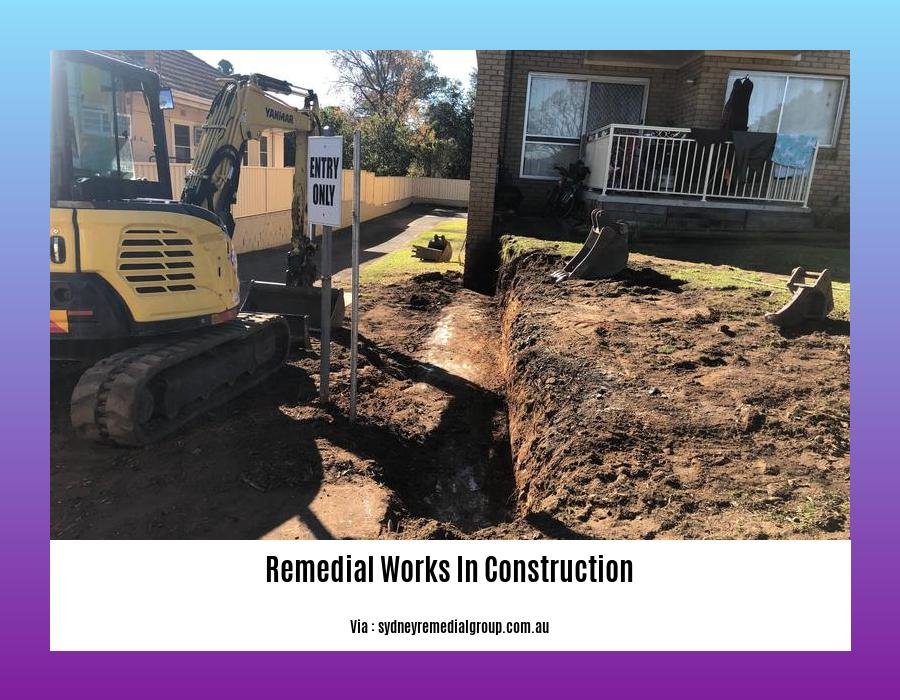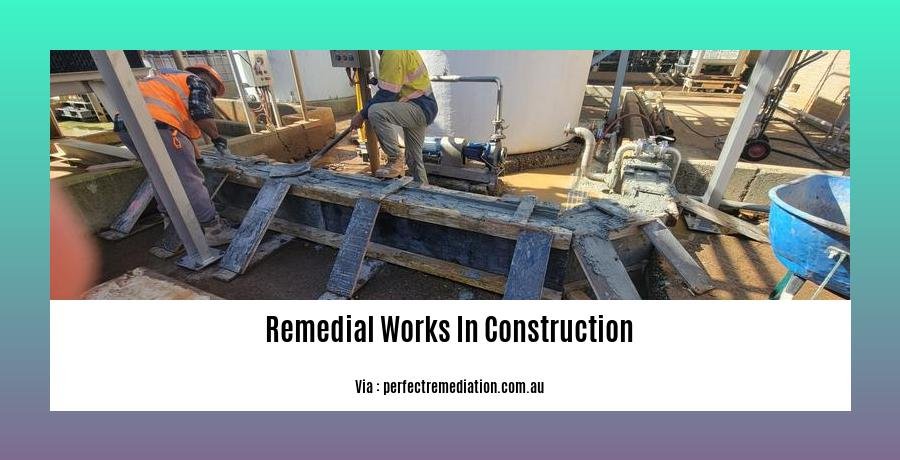Embark on a comprehensive journey through the realm of Remedial Works in Construction with our meticulously curated guide, offering a profound understanding of the techniques and strategies employed to restore damaged and deficient structures. Delve into the intricacies of identifying structural defects, developing effective remedial plans, and navigating the complexities of building codes and regulations.
Key Takeaways:
- Remedial works enhance structural integrity, prevent costly repairs, and uplift property value.
- They encompass repairs, upgrades, and defect corrections.
- Remedial works ensure buildings adhere to construction standards and regulatory requirements.
- By addressing building defects, remedial works increase operational efficiency and longevity.
Remedial Works in Construction

Remedial works are essential in construction to address defects and ensure buildings meet health and safety standards. These works involve altering a building’s structure to meet construction standards and regulatory requirements.
Benefits of Remedial Works:
- Maintain and Restore Structural Integrity: Remedial works help preserve the structural integrity of buildings, preventing further deterioration and ensuring the safety of occupants.
- Prevent Costly Repairs: By addressing defects promptly, remedial works prevent costly repairs and major renovations in the future.
- Enhance Property Value: Well-maintained buildings have higher property values compared to those with structural issues.
- Increase Operational and Logistical Efficiency: Remedial works improve the functionality and efficiency of buildings, reducing maintenance costs and improving operational efficiency.
Scope of Remedial Works:
Remedial works encompass a wide range of activities, including:
- Repair, Maintenance, and Upgrades on Older Buildings: Addressing aging structures, correcting defects, and upgrading systems to meet current standards.
- Defect Rectification and Corrective Actions on New Buildings: Resolving construction errors and addressing deficiencies to ensure structural integrity and safety.
Implementing Remedial Works:
To successfully implement remedial works, follow these steps:
- 1. Identify Defects and Damage: Conduct a thorough inspection to identify structural deficiencies, cracks, signs of water damage, or other potential hazards.
- 2. Develop a Remedial Plan: Based on the inspection, develop a comprehensive plan that outlines the necessary repairs and modifications.
- 3. Choose Qualified Contractors: Hire experienced and certified contractors who specialize in remedial works and have a proven track record.
- 4. Implement the Plan: Oversee the implementation of the remedial plan, ensuring that all works are done according to industry standards and regulations.
- 5. Monitor and Maintain: Regularly inspect the building after the works to ensure the effectiveness of the remedial measures and address any new issues that may arise.
Remedial works are crucial for maintaining the safety and integrity of buildings. By addressing defects promptly and professionally, you can protect your investment, enhance property value, and ensure a safe and functional environment for occupants.
-
Learn the meaning and uses of rebates in construction rebate meaning in construction.
-
Find out more about the types and techniques of residential roof construction.
-
Discover the definition and significance of α in construction.
-
Compare the features and benefits of α vs new construction windows.
-
Understand the purpose and placement of reveals in building construction.
-
Get insights into the use and significance of reveals in construction.
-
Explore the different types and applications of road construction equipment.
Repair and Restoration of Concrete Structures

Cracked, crumbling concrete structures pose safety hazards and compromise the integrity of buildings. When faced with these challenges, effective repair and restoration techniques are crucial to ensure the longevity and safety of concrete infrastructure.
Inspection and Evaluation
- Meticulously examine the structure for any visible damage, cracks, or deterioration.
- Structural engineers use non-destructive testing methods (e.g., ultrasonic, radiography) to assess the concrete’s internal condition.
Surface Preparation
- Deteriorated or damaged concrete is removed using methods such as chipping or hydro-demolition.
- Roughening the underlying concrete enhances the bond strength of the repair materials.
Repair Materials
- Patching mortars (e.g., cementitious, epoxy-based) are used to fill voids and cracks.
- Epoxy injections penetrate and seal deeper cracks within the concrete.
- Fiber-reinforced polymers (FRPs) provide structural reinforcement and enhance durability.
Repair Methods
- Patching involves filling small defects with suitable repair mortars.
- Grouting injects a fluid-based material into cracks or voids to restore structural integrity.
- Overlays involve applying a new layer of concrete over the existing surface.
- Jacketing involves encasing the damaged concrete with steel or FRP jackets to provide additional support.
Structural Strengthening
- When the concrete structure requires substantial reinforcement, additional reinforcement is applied.
- Carbon fiber sheets, steel plates, or post-tensioning systems improve the load-bearing capacity of the concrete.
Protection and Maintenance
- Protective coatings (e.g., sealers, paints) guard against water penetration and environmental factors.
- Regular monitoring of the repaired structure detects early signs of deterioration or further damage.
Key Takeaways:
- Concrete repair and restoration ensures the safety and durability of structures.
- Comprehensive inspection and evaluation guide appropriate repair methods and materials.
- Surface preparation is essential for effective bonding and lasting repairs.
- Advancements in materials and techniques enhance the effectiveness of repairs.
- Protective measures and ongoing maintenance extend the lifespan of restored structures.
Relevant Sources:
The Importance of Waterproofing in Construction: A Comprehensive Guide
Concrete Repairs & Rehabilitation: Methods, Materials & Considerations
Restoration of Historical and Heritage Buildings
Key points to consider:
When it comes to restoration of historical and heritage buildings, It’s all about preserving their historical significance while adapting them to modern needs. Here are a few key points to keep in mind:
-
Understanding the importance of documentation: Documenting the building’s history, condition, and restoration plans is a must to ensure the original character of the building is maintained.
-
Importance of using appropriate materials and techniques: Traditional materials and techniques should be prioritized to maintain the building’s historical character, while modern materials and technologies can be incorporated when sympathetic to the building’s heritage.
-
Sustainability in restoration: Consider the environmental impact of the restoration process and incorporate sustainable practices whenever possible to minimize the carbon footprint.
-
Adaptive reuse of heritage buildings: Explore new uses for heritage buildings while preserving their historical significance and architectural integrity. This can help to revitalize historic urban areas and give new life to old buildings.
-
Involving experts in the restoration process: The expertise of architects, engineers, historians, and other professionals is crucial for a successful restoration project. Their knowledge and experience can help to ensure that the building’s historical integrity is preserved.
-
Preservation and conservation: Focus on preserving and conserving original materials and features, minimizing alterations. This helps to maintain the building’s authenticity and historical significance.
Benefits of restoring historical and heritage buildings:
-
Protection of cultural heritage: Preserving these buildings helps protect our cultural heritage and tell the stories of the past.
-
Enhancement of urban aesthetics: Restored heritage buildings can contribute to the overall beauty and character of a city.
-
Providing new uses for historic buildings: Adaptive reuse of heritage buildings can bring new life to old structures and revitalize historic urban areas.
-
Economic benefits: Restoration projects can create jobs, stimulate economic development, and increase tourism.
Compliance with Building Codes and Regulations
In the landscape of construction, ensuring compliance with building codes and regulations is vital for the safety, integrity, and longevity of structures. It’s not just about checking boxes; it’s about recognizing the intent behind each regulation and applying them intelligently.
Why Compliance Matters:
- Public Safety: Codes prioritize safety by establishing minimum standards for design, construction, and materials. Compliance protects occupants from potential hazards.
- Structural Integrity: Regulations ensure buildings can withstand environmental loads (e.g., earthquakes, wind) and provide a stable foundation for years to come.
- Property Value: Compliant structures maintain their value and marketability, reassuring potential buyers that they’re investing in a safe and well-maintained property.
- Legal Liability: Ignoring codes can lead to costly legal battles, fines, and even criminal charges.
Key Steps to Compliance:
- Plan Early: Integrate code compliance into project planning from the outset.
- Hire Qualified Professionals: Engage architects, engineers, and contractors who are knowledgeable about building codes.
- Obtain Permits: Secure necessary permits before starting construction to ensure compliance.
- Monitor Regularly: Conduct regular inspections to ensure work meets code requirements.
- Document Thoroughly: Keep detailed records of all inspections, approvals, and modifications.
Consequences of Non-Compliance:
- Unsafe Structures: Ignoring codes can result in structural failures, endangering occupants and property.
- Legal Penalties: Non-compliant structures face legal action, including fines and potential criminal charges.
- Insurance Issues: Insurance companies may refuse coverage for non-compliant buildings.
- Reputational Damage: Non-compliance can damage the reputation of contractors, developers, and property owners.
Key Takeaways:
- Compliance with building codes and regulations is crucial for public safety, structural integrity, property value, and legal protection.
- Early planning, qualified professionals, and regular monitoring are essential for achieving compliance.
- Non-compliance carries severe consequences, including structural failures, legal penalties, insurance issues, and reputational damage.
Citations:
- GOV.UK: Code of Practice for the Remediation of Residential Buildings
- NSW Fair Trading: Remedial Building Work
FAQ
Q1: What are the key steps involved in remedial works?
Q2: What materials and techniques are used in concrete repairs and rehabilitation?
Q3: What are the important considerations for heritage building restoration?
Q4: How does the Code of Practice for the Remediation of Residential Buildings ensure accountability and compliance?
Q5: How are residents involved and protected during remedial works projects?
- Are Daffodils Perennials?A Complete Guide to Planting & Care - March 31, 2025
- Are Carpenter Bees Dangerous? Stings, Damage, and Control - March 31, 2025
- How to Get Rid of Ants in the Washroom: A Complete Guide - March 31, 2025










